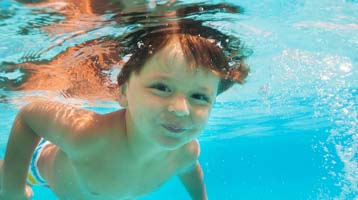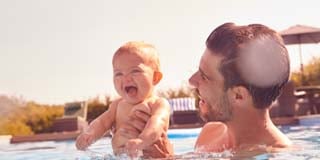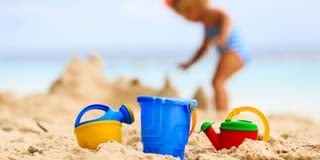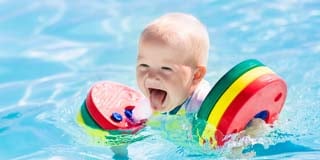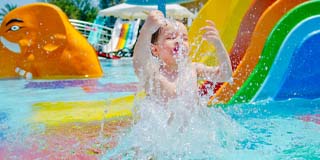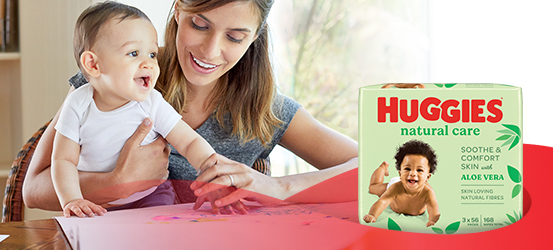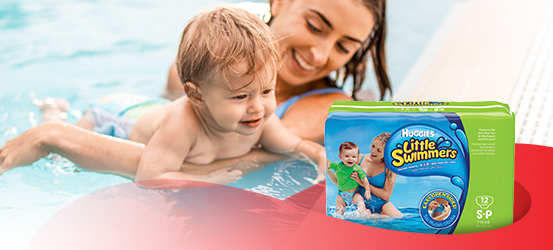You can start teaching your little one some fundamental swimming skills when they are as young as 6 months old. The good thing is you just need to refresh your baby’s memory; they did spend 9 months in a liquid-filled sack inside the womb and have some instinctive swimming skills already.
Swimming is great for your tot as it can give them an independence that they have probably not felt yet. They are almost weightless in water and can move their arms and legs to their hearts content without any fear of falling down. Teaching your baby basic swimming skills can also be a really good bonding experience for you and your child. You could even hold off formal swimming lessons until your child is 4 years old. It’s also a good idea to teach your baby basic swimming skills from a safety perspective. Any accidents in a pool can be a tragedy for untrained swimmers. If your basic swimming skills lessons are going to take place in a public pool, try to go during an off-peak time, as babies and toddlers can get a little stressed when there are a lot of unfamiliar people and noises.
Teaching basic swimming skills
The first skill you can impart on your child is familiarity and comfort with water. With any kind of swimming programme, this is a good place to start. You can start before you even get to the pool; get your baby used to water by having extra long, extra splashy baths. If your kids are old enough, running through a sprinkler can also be heaps of fun and aid in getting your child more comfortable with water.
Once your tot is comfortable with water, you need to encourage them to try to put their head underwater (but only if they are old enough to do this). This can often be the make or break stage in the early swimming schooling process. If your child is comfortable putting their head underwater, then you should show them how to blow bubbles, this will stop water from getting into your baby’s nose and mouth. You can also demonstrate how to blow bubbles by taking a deep breath in, putting the lower half of your face under water, and blowing the air out of your mouth to create bubbles in the water. Your baby should be encouraged to blow bubbles by mimicking you.
Floating is the next swimming skill you should teach your baby. It’s a pretty important ability for your child to have, as it gives them the ability to stay afloat in the water if they accidentally get into water that is too deep for them while swimming, or if they fall into the pool. A good way to get this started is to ask your child to imagine they are lying on their bed but in the pool. Get your tot to lie on their back in the pool, and then support your tot’s head with one hand and the other under their back. As your baby gets used to the sensation of floating, slowly release your support from them, and they will be floating all by themselves. But stay within arm’s length.
Different strokes for different folks
Your little one might not be ready to master the butterfly kick or excel at backstroke yet, but you can still give them some good grounding for the future by teaching them some basic swimming stroke techniques and positions. One of the first things to master is a strong kick.
Gently guide your child to the side of the pool and get them to hold onto the ledge whilst you do the same thing. Then proceed to have a game by seeing who can splash the most while kicking (It is best to let your child win this one). Next get a kick board, so they can move on to crossing the pool with them only kicking. Repeat and practice as often as you can until your child gets the knack of kicking. Always stay close! Never leave a child unattended in a pool.
Then teach them to doggy paddle – where they learn to kick and row to keep their head above water. Once doggy paddle has been mastered, and they are comfortable to have their heads under water, you can move on to teaching them the formal swimming styles. The first of which is crawl (also known as freestyle), it is the easiest of the swimming strokes to learn.
Step 1: let them do kicking with the board and their heads under water “blowing bubbles” – teach them to turn their heads from side to side to take a new breath. It is important to start off with the board – it gives them a sense of security and improves their confidence in doing the stroke.
Step 2: let them grasp the board between their legs and row with their arms, rotating head from side to side for each breath.
The Final Step: let go of the board and there you go. This is where they sometimes forget everything – so stay close. Get your child to try propel themselves forward by rotating their arms in a windmill motion, and kicking their legs in a fluttering motion. Co-ordinating breathing with the stroke is pretty tough, and it might be something that your toddler or child will only grasp after quite a bit of practice.
Backstroke is almost exactly like crawl except you teach your child to do the stroke on their back. This might be pretty testing, as they have no idea where they are going, so it might be a good idea to hold off on the backstroke until you have a proper little water baby on your hands. Breaststroke and Butterfly involve some seriously technical and co-ordinated movements and probably should only be taught when your child is older, more comfortable in the water and has better muscle co-ordination.
Basic swimming skills help toddlers feel more confident in their abilities and decrease their dependence on flotation devices in the pool. Most toddlers will be around some sort of water in their lives. Learning basic swimming skills will give toddlers the ability to stay safe in the water and feel more secure near lakes and pools. Of course, no matter how well your children can swim, you will never stop watching them very closely around water; accidents can happen in the blink of an eye and must be avoided at all costs!

